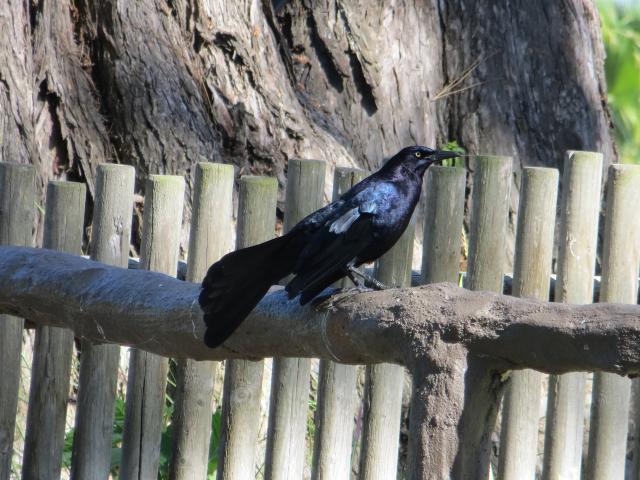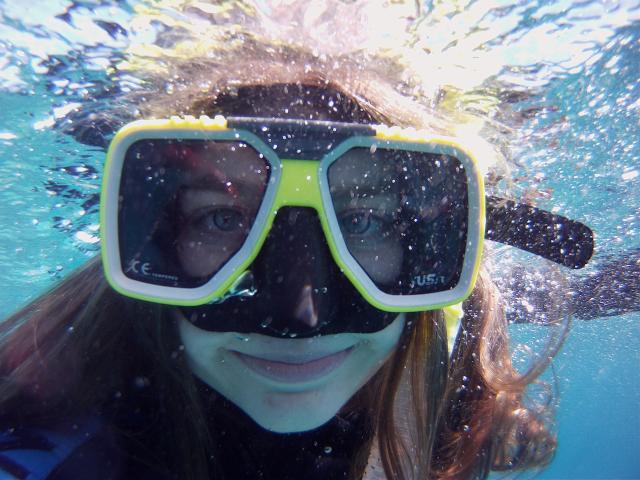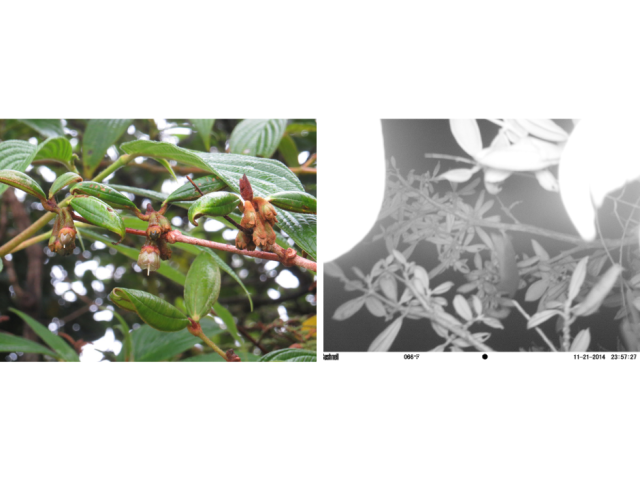Passion and Real-world Impact: Meet Christin Palmstrom ‘15 (CCS Biology) ‘18 (Bren Environmental Science and Management)
Christin pursues her calling for environmental communications

Christin Palmstrom is a 2015 College of Creative Studies (CCS) biology graduate who pursued her passion for biology and conservation at the University of California, Santa Barbara (UCSB). As an undergraduate, Christin conducted research, studied abroad in Australia and Costa Rica, and found her interest in pursuing a career in environmental communications that would allow her to combine science with a creative field while using storytelling to have a positive impact. Christin returned to UCSB and in 2018 received a Master’s degree in environmental science & management from the Bren School of Environmental Science & Management (Bren). Soon thereafter, this alumna took the opportunity to remain on campus and became the CCS communications & development associate. In early 2023, Christin was excited to return to the environmental field as the communications & outreach coordinator for the newly launched The 2035 Initiative, a “think and do” tank at UCSB built to confront the climate crisis and develop actionable roadmaps for slashing climate pollution and ushering in a more equitable, resilient future. In this story, Christin shares her academic and professional experience as well as provides advice to current and future students.

“One area I have always been passionate about is biology and conservation. I love learning about the world around us and want to support solutions to protect the environment. CCS ended up being the perfect place to explore my interest in biology and conservation.”
—Christin Palmstrom ‘15 (CCS Biology) ‘18 (MESM, Bren Master of Environmental Science and Management)
I grew up on nature documentaries, exploring zoos, and visiting science museums as well as with a love of learning. Though one thing I did not have was a clear career plan. While I had many friends who knew what they wanted to do, I had a hard time narrowing down my interests. Still, one area I have always been passionate about is biology and conservation. I love learning about the world around us and want to support solutions to protect the environment.
When I was looking at colleges, I was initially interested in the College of Creative Studies (CCS) because of its focus on research, community, and the ability to tailor your learning experience to fit your interests. I also liked the idea of being a part of a small community while enjoying the opportunities offered by a large campus. CCS ended up being the perfect place to explore my interest in biology and conservation.
I arrived on campus during the summer of 2011 as a newly enrolled student in the Freshman Summer Start Program (FSSP). I was excited and a little nervous to be at UCSB, and I appreciated the opportunity to experience the campus before the chaos of the full academic year began. I started taking classes, made friends, and learned about many of the resources offered on campus. Fall quarter came quickly and kicked off with my first CCS All College, a memorable experience with CCS Dean Bruce Tiffney walking around with a pool noodle to keep the event on track. With the start of the quarter, I also began the introductory biology series and connected with my College peers.
As I was busy with classes, I also wanted to dive into research. I first started by studying mammalian microfossils in Professor Andy Wyss’ lab in the department of earth science. Next, I worked with Dr. Corina Logan at the SAGE Center for the Study of the Mind to study animal behavior with a particular focus on social learning in great-tailed grackles. Great-tailed grackles are a medium-sized bird in the Icteridae family and are known for their adaptability and creative foraging habits, such as picking dead insects off of the license plates of parked cars. As part of my research, I observed grackles in the wild around Santa Barbara, trained a grackle on how to solve an apparatus for a food reward to see if other grackles learned from this individual, and worked with the Cheadle Center for Biodiversity and Ecological Restoration (CCBER) to borrow a collection of grackle skulls for an endocranial volume measurement study.

Over the next few years, I enjoyed working on research and taking classes from CCS (including CCS Biology Faculty Claudia Tyler’s amazing walking biology course) and across campus. I joined study groups in the library and met up with classmates in Isla Vista to work on projects. While I learned about ecology, vertebrates, conservation, and other aspects of biology, I also learned much more than just my major. I learned how to think critically, solve problems, and to think through not just “what” is happening, but “why.” I had the freedom to take courses from departments across campus, and explored classes outside of my major, including in physics, literature, film and media studies, and psychology. I appreciated that the structure of CCS allows students to follow their curiosity, wherever it may lead them, and that my advisor, CCS Biology Faculty Claudia Tyler, always encouraged me to take classes that I was interested in. Additionally, Claudia, along with CCS Biology Faculty John Latto and other CCS Biology Faculty would share opportunities they thought I would be interested in and, in turn, empowered me to pursue my interests.
“I was also really passionate about wanting to study abroad during my time as an undergraduate and I was fortunate enough to have the opportunity to study abroad twice [Australia and Costa Rica]. As part of the study abroad program [in Costa Rica], we had the opportunity to design and conduct our own research experiment.”
—Christin Palmstrom ‘15 (CCS Biology) ‘18 (MESM, Bren Master of Environmental Science and Management
I was also really passionate about wanting to study abroad during my time as an undergraduate and I was fortunate enough to have the opportunity to study abroad twice. The summer before my 4th year, I traveled to Australia for a program in wildlife and conservation, where I traveled around the country, including to Brisbane, Sydney, and Cairns. I learned about Australia’s unique wildlife and many of the conservation challenges they face, including from habitat loss, invasive species, and climate change, as well as some of the controversial components of conservation, from funding conservation efforts to managing populations of beloved but destructive animals, such as wild horses. And no trip to Australia would be complete without an up close encounter with the Great Barrier Reef which I saw first hand through a snorkeling expedition in Cairns.

The following Fall, I studied abroad in Costa Rica. As part of the study abroad program, we had the opportunity to design and conduct our own research experiment. I set up an experiment to study the pollination of Blakea chlorantha, a woody plant with small green, bell-shaped flowers found in the cloud forests of Monteverde. B. chlorantha is believed to be rodent pollinated and I wanted to see if I could find evidence to support this theory. For two weeks, I hiked to study sites in the cloud forest to observe flowers. I put fluorescent dust on flowers in the evenings and checked if the dust had transferred to other flowers in the morning, which would be indicative of rodent visitors transferring pollen during the night. I also set up rodent traps around the plants to see if any captured rodents had pollen on them and I placed camera traps around flowers to observe if rodents visited the flowers. At the conclusion of my project, I found no evidence of dust transfer and no pollen on any rodents caught, but I did capture photos of rodents visiting the plants. So my project ended where it began, that maybe rodents pollinate B. chlorantha.
“This program [Carsey-Wolf Center’s Blue Horizon], an environmental documentary “bootcamp,” sparked my interest in pursuing a career in environmental communications. I loved the idea of combining science with a creative field. I wanted to bring academic work to a broader audience and use storytelling to have impact.”
—Christin Palmstrom ‘15 (CCS Biology) ‘18 (Bren Environmental Science and Management
As graduation came closer and closer, I wasn’t sure what I wanted to do after college. Like many soon-to-be-graduates, I was struggling with the dreaded question of “what do I do next?” As much as I enjoyed working on research, I still did not have a clear career trajectory. However, at the end of my CCS undergraduate studies, I participated in the Carsey-Wolf Center’s Blue Horizons program. This program, an environmental documentary “bootcamp,” sparked my interest in pursuing a career in environmental communications. I loved the idea of combining science with a creative field. I wanted to bring academic work to a broader audience and use storytelling to have impact.
Following Blue Horizons, I spent a year taking classes in communications and filmography at Santa Barbara City College (SBCC) to broaden my experience with these fields. I then applied to the UCSB Bren School of Environmental Science & Management which has professional master’s degree programs. After two intense years studying with other environmental professionals, I graduated with a Masters’s in Environmental Science and Management degree with a specialization in conservation planning and a focus on strategic environmental communications and media.
After graduating, I became one of the many alumni who couldn’t leave campus and began working at UCSB, eventually finding myself back at CCS. I was excited to join the CCS staff team as a communications & development associate. For the next three and a half years, I worked with an incredible team to write stories about the College and its radically curious students, alumni, and faculty, plan events and conferences, photograph students, and help with fundraising efforts to support the College. It was exciting being part of the dedicated staff that makes CCS run, including working together to adapt to the changing conditions during the COVID-19 pandemic.
In 2022, The 2035 Initiative launched on campus. The 2035 Initiative is a new “think and do” tank built to confront the climate crisis and develop actionable roadmaps for slashing climate pollution and ushering in a more equitable, resilient future. I was excited to get back into the environmental field and applied for a job as a communications & outreach coordinator. I was offered the position and at the beginning of 2023, I started my current role on campus. In my role, I work with faculty across the Initiative to strategize on how to increase the impact of their research and share their work with policymakers, journalists, advocates, and other stakeholders. This includes developing communication material, such as press releases, articles, and policy briefs as well as through coordinating with external partners and the media. Additionally, I provide production support for the climate podcast, A Matter of Degrees.
Since I started, we have launched projects on increasing electricity grid resilience for disadvantaged communities to developing roadmaps for industrial decarbonization and investigating strategies to increase community acceptance of large-scale solar. Instead of focusing on individual actions, we want to develop policies to address the climate crisis. We use empirical research, policy development, and media engagement to accelerate the clean energy transition, phase out fossil fuels, and adapt to climate change.
“My journey has led me to my current career where I take my passion for biology and conservation to have real-world impact by supporting environmental policy development…I really enjoy this work!…So for current and future students, I would say that it’s okay to not know where you will go, to change directions, and to follow twists and turns. I encourage you to take advantage of the many opportunities at CCS and to follow your passions, wherever they take you.”
—Christin Palmstrom ‘15 (CCS Biology) ‘18 (Bren Environmental Science and Management)
My journey has led me to my current career where I take my passion for biology and conservation to have real-world impact by supporting environmental policy development. I combine my research and science background with communications to support transformational change in the United States and throughout the world. I really enjoy this work! I didn’t know that this is where I would end up when I started at CCS, but it is thanks to the opportunities and support I had from CCS and UCSB that I found my path. So for current and future students, I would say that it’s okay to not know where you will go, to change directions, and to follow twists and turns. I encourage you to take advantage of the many opportunities at CCS and to follow your passions, wherever they take you.
Photos courtesy of Christin Palmstrom ‘15 (CCS Biology) ‘18 (Bren Environmental Science and Management)
Christin’s story is a snapshot of the College’s amazing alumni. CCS welcomes its alumni to share their stories (contact us at info@ccs.ucsb.edu) and encourages them to reconnect and visit. You can still find us at Building 494!